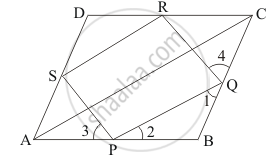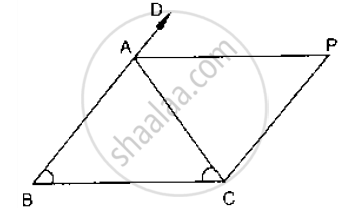Advertisements
Advertisements
Question
The figure formed by joining the mid-points of the adjacent sides of a rhombus is a
Options
square
rectangle
trapezium
none of these
Solution
Figure is given as :

A rhombus ABCD is given in which P, Q, R and S are the mid-points of sides AB, BC, CD and DA respectively.
In ΔABC, P and Q are the mid-points AB and BC respectively.
Therefore,
PQ || AC and `PQ = 1/2 AC` ……(i)
Similarly, In ΔADC,R and S are the mid-points CD and AD respectively.
Therefore, SR || AC and `SR = 1/2 AC` ……(ii)
From (i) and (ii), we get
PQ|| SR and PQ = SR
Therefore, PQ RS is a parallelogram. …… (iii)
Now, we shall find one of the angles of a parallelogram.
Since ABCD is a rhombus
Therefore,
AB = BC (Sides of rhombus are equal)
`1/2 AB = 1/2 BC`
PB = BQ (P and Q are the mid-points AB and BC respectively)
In ΔPBQ, we have
PB = BQ
∠1 =∠2 (Angle opposite to equal sides are equal)
Therefore, ABCD is a rhombus
AB = BC
`1/2 AB = 1/2 BC`
AP = CQ …… (iii)
Also,
CD = AD
`1/2 CD = 1/2 AD`
CR = AS…… (iv)
Now, in ΔAPS and ,ΔCQR we have
AP = CQ [From (iii)]
CR = AS [From (iv)]
And PS = QR (PQRS is a parallelogram)
So by SSS criteria of congruence, we have
ΔAPS ≅ ΔCQR
By Corresponding parts of congruent triangles property we have:
∠3 = ∠4 …… (v)
Now, ∠1 +∠PQR + ∠4 = 180°
And ∠3 +∠SPQ +∠2 = 180°
Therefore,
∠3 +∠SPQ +∠2 = ∠1 +∠PQR +∠4 From (ii), we get ∠1 =∠2
From (v), we get ∠3 = ∠4
Therefore, ∠SPQ = ∠PQR…… (vi)
Now, transversal PQ cuts parallel lines SP and RQ at P and Q respectively.
∠SPQ +∠PQR = 180°
∠SPQ +∠SPQ = 180° [Using (vi)]
∠SPQ = 90°
Thus, PQRS is a parallelogram such that ∠SPQ = 90°.
Therefore, PQRS is a rectangle.
Hence the correct choice is (b).
APPEARS IN
RELATED QUESTIONS
In a parallelogram ABCD, determine the sum of angles ∠C and ∠D .
ABCD is a square. AC and BD intersect at O. State the measure of ∠AOB.
The sides AB and CD of a parallelogram ABCD are bisected at E and F. Prove that EBFD is a parallelogram.
In a ΔABC median AD is produced to X such that AD = DX. Prove that ABXC is a
parallelogram.
In Fig. below, AB = AC and CP || BA and AP is the bisector of exterior ∠CAD of ΔABC.
Prove that (i) ∠PAC = ∠BCA (ii) ABCP is a parallelogram

In a parallelogram ABCD, write the sum of angles A and B.
In a parallelogram ABCD, if ∠D = 115°, then write the measure of ∠A.
In a parallelogram ABCD, the bisector of ∠A also bisects BC at X. Find AB : AD.
In the given Figure, if AB = 2, BC = 6, AE = 6, BF = 8, CE = 7, and CF = 7, compute the ratio of the area of quadrilateral ABDE to the area of ΔCDF. (Use congruent property of triangles)
Prove that the quadrilateral formed by the bisectors of the angles of a parallelogram is a rectangle.
